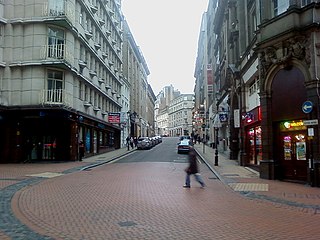
Georgian architecture is the name given in most English-speaking countries to the set of architectural styles current between 1714 and 1830. It is named after the first four British monarchs of the House of Hanover, George I, George II, George III, and George IV, who reigned in continuous succession from August 1714 to June 1830.

The Hall of Memory is a war memorial in Centenary Square, Birmingham, England, designed by S. N. Cooke and W. N. Twist. Erected 1922–25 by John Barnsley and Son, it commemorates the 12,320 Birmingham citizens who died in World War I.

Sir William Tite was an English architect who twice served as President of the Royal Institute of British Architects. He was particularly associated with various London buildings, with railway stations and cemetery projects. He was the Member of Parliament (MP) for Bath from 1855 until his death.

John Claudius Loudon was a Scottish botanist, garden designer and author, born in Cambuslang in 1782. He was the first to use the term arboretum in writing to refer to a garden of plants, especially trees, collected for the purpose of scientific study. He was married to Jane Webb, a fellow horticulturalist, and author of science-fiction, fantasy, horror, and gothic stories.

Thomas Rickman was an English architect and architectural antiquary who was a major figure in the Gothic Revival. He is particularly remembered for his Attempt to Discriminate the Styles of English Architecture (1817), which established the basic chronological classification and terminology that are still in widespread use for the different styles of English medieval ecclesiastical architecture.

Albert Square is a public square in the centre of Manchester, England. It is dominated by its largest building, the Grade I listed Manchester Town Hall, a Victorian Gothic building by Alfred Waterhouse. Other smaller buildings from the same period surround it, many of which are listed.

Although Birmingham in England has existed as a settlement for over a thousand years, today's city is overwhelmingly a product of the 18th, 19th, and 20th centuries, with little surviving from its early history. As it has expanded, it has acquired a variety of architectural styles. Buildings of most modern architectural styles in the United Kingdom are located in Birmingham. In recent years, Birmingham was one of the first cities to exhibit the blobitecture style with the construction of the Selfridges store at the Bullring Shopping Centre.

Prior Park is a Neo-Palladian house that was designed by John Wood, the Elder, and built in the 1730s and 1740s for Ralph Allen on a hill overlooking Bath, Somerset, England. It has been designated as a Grade I listed building.

Abney Park Chapel, is a Grade II Listed chapel, designed by William Hosking and built by John Jay that is situated in Europe's first wholly nondenominational cemetery, Abney Park Cemetery, London.

The Parish Church of St Peter and St Paul in Witton Lane, Aston, Birmingham, England, is a parish church in the Church of England.

Warstone Lane Cemetery,, also called Brookfields Cemetery, Church of England Cemetery, or Mint Cemetery, is a cemetery dating from 1847 in Birmingham, England. It is one of two cemeteries in the city's Jewellery Quarter, in Hockley. It is no longer open to new burials.

London's architectural heritage consists of buildings from a wide variety of styles and historical periods. London's distinctive architectural eclecticism stems from its long history, continual redevelopment, destruction by the Great Fire of London and The Blitz, and state recognition of private property rights which have limited large-scale state planning. This sets London apart from other European capitals such as Paris and Rome which are more architecturally homogeneous. London's diverse architecture ranges from the Romanesque central keep of The Tower of London, the great Gothic church of Westminster Abbey, the Palladian royal residence Queen's House, Christopher Wren's Baroque masterpiece St Paul's Cathedral, the High Victorian Gothic of The Palace of Westminster, the industrial Art Deco of Battersea Power Station, the post-war Modernism of The Barbican Estate and the Postmodern skyscraper 30 St Mary Axe 'The Gherkin'.

St Peter's Square is a public square in Manchester city centre, England. The north of the square is bounded by Princess Street and the south by Peter Street. To the west of the square is Manchester Central Library, Midland Hotel and Manchester Town Hall Extension. At the centre of the square is St Peter's Square Metrolink tram stop, a major transport interchange. The square is also home to the Manchester Cenotaph, and the statue of Emmeline Pankhurst Rise up, Women In 1819, the area around the square was the site of the Peterloo Massacre.

Bennetts Hill is a street in the core area of Birmingham City Centre, United Kingdom. It runs from New Street, uphill to Colmore Row, crossing Waterloo Street in the process. It is within the Colmore Row conservation area.

The Church of St. Joseph is an 18th-century church in Waterloo, Belgium, dedicated to Saint Joseph.

John Norton was an English architect who designed country houses, churches and a number of commercial buildings.
Samuel Nathaniel Cooke Jr. was an English architect active in Birmingham, England in the early to mid 20th century. He was almost invariably credited as S. N. Cooke and his later work was carried out under the auspices of his firm S. N. Cooke and Partners. Works by him and the partnership include significant civic buildings, hospitals, and commercial premises in Birmingham and elsewhere in the United Kingdom.

St Thomas' Church, Bath Row, is a former Church of England parish church in Birmingham.

St Clement's Church, King Square, is a Church of England parish church in Finsbury, Central London, in the London Borough of Islington. It is adjacent to King Square, within a walking distance from City Road.

Romanesque Revival, Norman Revival or Neo-Norman styles of building in the United Kingdom were inspired by the Romanesque architecture of the 11th and 12th centuries AD.





















